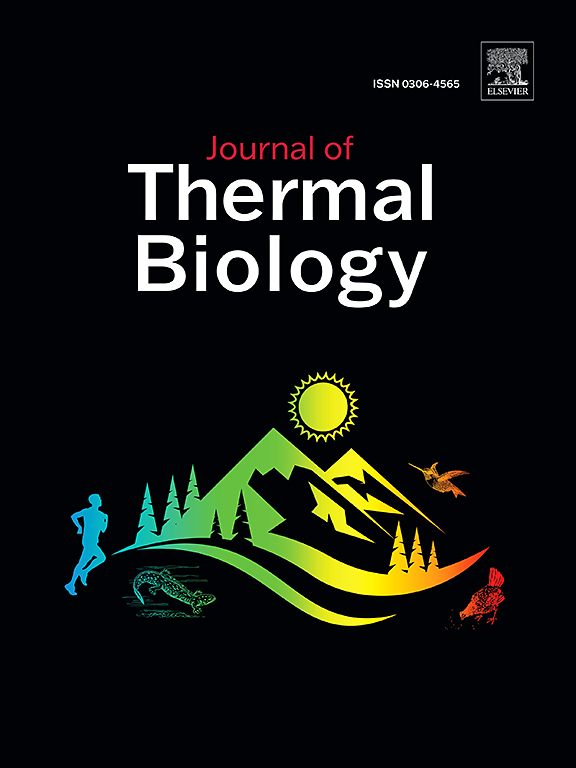热上限在不同体质的河口鱼类中是 "硬连接 "的,但在不同种群中并非如此。
IF 2.9
2区 生物学
Q2 BIOLOGY
引用次数: 0
摘要
随着气候变暖,热浪的频率和强度不断增加,气温也突破了特殊阈值。预测物种对气候变暖的脆弱性的工作往往侧重于威胁生存的热上限,而忽视了种内变异在决定脆弱性方面的作用。我们以河口鱼类(黑鲷鱼)为模型,探讨了种内体重差异和种群间差异如何影响热耐受上限。我们使用野生鱼类的临界最大热量(CTmax)来量化热上限。我们使用体重范围为 500 克(平均值 = 52.4 克,范围 = 0.57-541 克)来检验体重与热耐受性之间的关系。沿 5° 纬度线选择了四个不同的团头鲂种群,以探索种群在热极限方面的差异。与预期相反,体质量对热上限没有影响。不过,观察到种群在耐热性方面存在明显差异,这与平均栖息地温度有关。具体地说,与北部(36.32 ± 0.70 °C)和中纬度(36.36 ± 1.15 °C)种群相比,南部种群的 CTmax(35.57 ± 0.43 °C)明显较低。这些数据强调了观察种内热极限变化的重要性,以揭示物种内个体应对气候变暖的能力,并改善对濒危生命阶段和种群的管理。本文章由计算机程序翻译,如有差异,请以英文原文为准。
Upper thermal limits are ‘hard-wired’ across body mass but not populations of an estuarine fish
Climate warming is seeing temperatures breach exceptional thresholds as the frequency and intensity of heat waves increase. Efforts to forecast species vulnerability to climate warming often focus on upper thermal limits threatening survival, overlooking the role of intraspecific variation in determining vulnerability. Using an estuarine fish (black bream, Acanthopagrus butcheri) as a model, we explore how intraspecific variation in body mass and among populations affects upper thermal tolerance. Upper thermal limits were quantified using critical thermal maxima (CTmax) of wild fish. We used a ∼500 g (mean = 52.4 g, range = 0.57–541 g) mass range to test the relationship between body mass and thermal tolerance. Four distinct black bream populations were chosen along a 5° latitudinal cline to explore population differences in thermal limits. Contrary to expectations, there was no effect of body mass on upper thermal limits. However, significant population differences in thermal tolerance were observed that correlate with mean habitat temperatures. Specifically, the southern population had a significantly lower CTmax (35.57 ± 0.43 °C) compared to northern (36.32 ± 0.70 °C) and mid-latitude (36.36 ± 1.15 °C) populations. These data underscore the importance of observing intraspecific variation in thermal limits to reveal the capabilities of individuals within a species to cope with climate warming and improve the management of at-risk life stages and populations.
求助全文
通过发布文献求助,成功后即可免费获取论文全文。
去求助
来源期刊

Journal of thermal biology
生物-动物学
CiteScore
5.30
自引率
7.40%
发文量
196
审稿时长
14.5 weeks
期刊介绍:
The Journal of Thermal Biology publishes articles that advance our knowledge on the ways and mechanisms through which temperature affects man and animals. This includes studies of their responses to these effects and on the ecological consequences. Directly relevant to this theme are:
• The mechanisms of thermal limitation, heat and cold injury, and the resistance of organisms to extremes of temperature
• The mechanisms involved in acclimation, acclimatization and evolutionary adaptation to temperature
• Mechanisms underlying the patterns of hibernation, torpor, dormancy, aestivation and diapause
• Effects of temperature on reproduction and development, growth, ageing and life-span
• Studies on modelling heat transfer between organisms and their environment
• The contributions of temperature to effects of climate change on animal species and man
• Studies of conservation biology and physiology related to temperature
• Behavioural and physiological regulation of body temperature including its pathophysiology and fever
• Medical applications of hypo- and hyperthermia
Article types:
• Original articles
• Review articles
 求助内容:
求助内容: 应助结果提醒方式:
应助结果提醒方式:


